by Mike Sessler, ChurchTechArts.org
I was about to start this article off with the phrase, "A few weeks ago..." but then I realized it was actually a few months ago now. Anyway, a few months ago, we had the privilege of hosting Camron Ware at Coast Hills as he did a hands-on demonstration of Environmental Projection (EP). Camron is a great guy; very knowledgeable and very humble. He will say he didn't invent EP, but he certainly has been a driving force in helping churches all over the world get up and running with EP systems and media.
When I was approached about hosting this event, I was a little concerned that our room would not be conducive to EP as the front of our auditorium is a mishmash of curtains, walls, screens, angles and the stage. It didn't take long to find I was wrong. The first thing Camron did was to set up three projectors. Two were supplied by a local vendor (a pair of Chrisite 5Ks). The other one arrive with Camron in a suitcase. No kidding. He walked in with a rolling suitcase in tow, and pulled out a projector the size of two pizza boxes. Made by Hitachi, it spits out 4000 lumens and costs about $2,000. I believe this is the one: Hitachi CP-X4021N LCD Video Projector.

After connecting all three projectors to his MacBook Pro using a TripleHead2Go from Matrox, he threw up this very cool grid in Photoshop. He created this to help him create the mask he uses in ProPresenter to mask out the areas he doesn't want to project on. He spent about 10 minutes creating the mask, though he conceded that in a real installation or bigger show, he might spend quite a bit more time getting it dialed in perfectly.
The images used for the backgrounds can be almost anything. Camron talked a lot about how cathedrals of old had all sorts of beautiful details and architectural features. Today, we build beige boxes. EP can be used to put some visual interest back into the worship space. To wit...

That one has a very modern, grafitti feel. But you could just as easily go ancient.

Note in this case, he's projecting over our IMAG screens. In the previous example, he masked them out. This was done using different masks in the Mask layer of ProPresenter 4. It should also be noted that these images are not edge-blended in any way. He's found that typically the building has enough breakup in the design that the slight overlap of images from the projectors doesn't matter that much. By tweaking the mask, he made it look seamless, even though it wasn't. Here's another.

Camron had a lot of tips for us that day, and I won't try to recap them all. A few items of note however: Someone asked about projecting on the side walls. He said he's found that to be distracting. It's hard to tell from the photos, but standing in the room, the area of projection just about fills your field of veiw. The side walls are in the periphery. If we were projecting on them, especially with moving backgrounds, it's easy to draw people's eyes away from the front, which is distracting. It's better to carry the color down the side walls with LED washes.
Speaking of motion, you want to keep things moving slowly. Something moving an inch on your screen will move ten feet or more when projected, so be careful with that. Experiment first with static images, then once you get the hang of that, start on motion. Try motion backgrounds out before Sunday.
And when you find yourself projecting on horizontal surfaces, like the area over the front of our stage, make sure to mask it out, as it looks very strange otherwise. The following picture serves as a negative example.

In this case, he removed the mask and as you can see, it looks really weird with the buildings zig-zagging up the front.
There is a lot more to say about EP, but clearly I'm no expert. I suggest you check out Camron's website, Visual Worshiper, to get the full scoop. When it comes to EP in the church, he's the man. One other takeaway; it doesn't need to be crazy-expensive to do EP. For example, three of those Hitachi projectors would set you back about $6,000. A TripleHead2Go is about $300. Of course, you'd also need a computer and software, but you may have that already. When you compare that to the cost of a few moving head lights, it's really pretty affordable. It's also important to note that you don't need 16K lumen projectors to make this work, either. The center of the image is being projected from almost 95' away from a 4,000 lumen projector. The two sides are 50' away from 5,000 lumen projectors (the fact that they don't look different says a lot about how projectors are rated...). 4,000 Lumens is certainly enough for most situations, especially when you can control the ambient light. We're also running house lights near full, just so you know.
